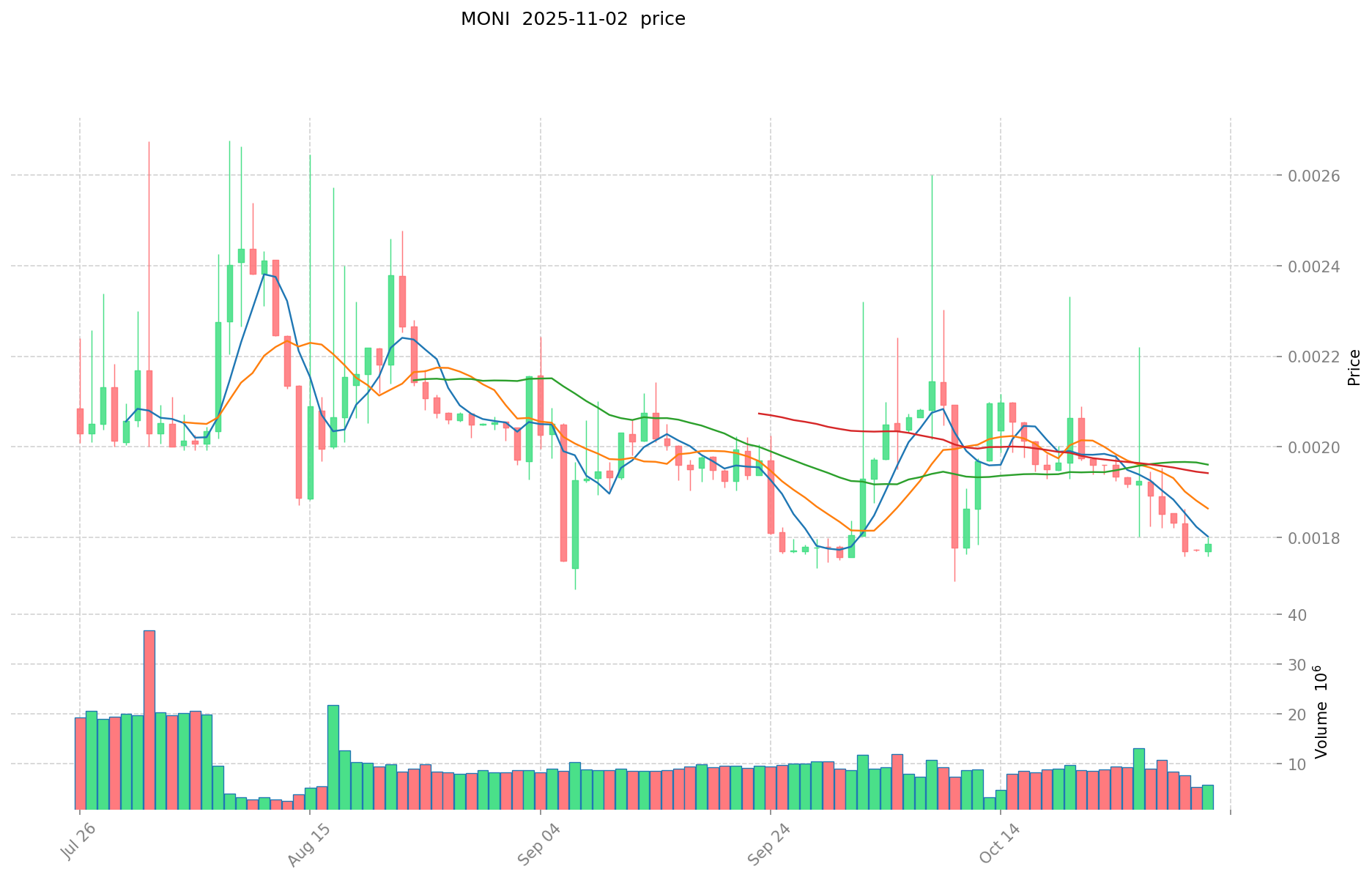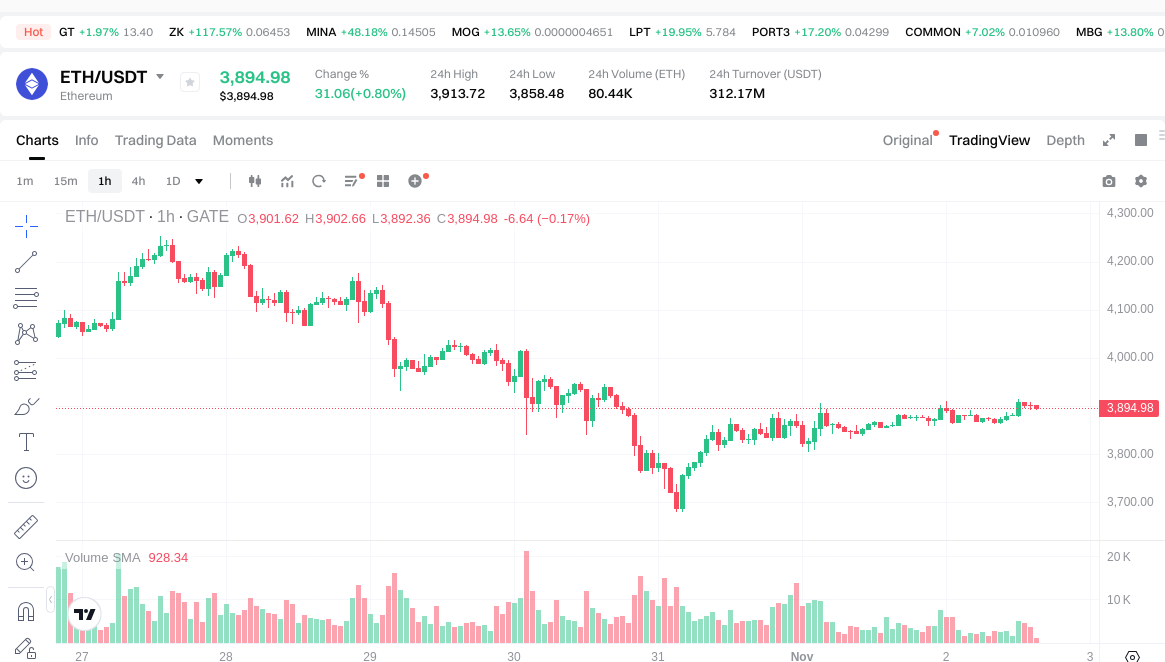MONI vs ETH: The Battle for Decentralized Finance Supremacy
Introduction: MONI vs ETH Investment Comparison
In the cryptocurrency market, the comparison between Monsta Infinite (MONI) vs Ethereum (ETH) has been an unavoidable topic for investors. The two differ significantly not only in market cap ranking, application scenarios, and price performance, but also represent different cryptocurrency asset positioning.
Monsta Infinite (MONI): Since its launch in 2021, it has gained market recognition for its focus on GameFi and MMORPG experiences.
Ethereum (ETH): Since its inception in 2015, it has been hailed as the foundation for decentralized applications and smart contracts, and is one of the cryptocurrencies with the highest global trading volume and market capitalization.
This article will comprehensively analyze the investment value comparison between MONI vs ETH, focusing on historical price trends, supply mechanisms, institutional adoption, technical ecosystems, and future predictions, attempting to answer the question investors care about most:
"Which is the better buy right now?"
I. Price History Comparison and Current Market Status
MONI and ETH Historical Price Trends
- 2021: MONI reached its all-time high of $4.87 due to initial market enthusiasm.
- 2022: ETH experienced significant volatility during the broader crypto market downturn.
- Comparative analysis: In the current market cycle, MONI has fallen from its $4.87 peak to $0.001869, while ETH has shown more resilience, currently trading at $3899.11.
Current Market Situation (2025-11-02)
- MONI current price: $0.001869
- ETH current price: $3899.11
- 24-hour trading volume: $13,200.49 (MONI) vs $311,124,083.88 (ETH)
- Market Sentiment Index (Fear & Greed Index): 33 (Fear)
Click to view real-time prices:
- View MONI current price Market Price
- View ETH current price Market Price


ETH Investment Value Analysis
Fundamental Factors Driving ETH's Investment Value
Supply Mechanism (Tokenomics)
- ETH: No fixed supply cap like Bitcoin, but implements a deflationary model through EIP-1559 burning mechanism combined with PoS emissions reduction, potentially creating net deflation during high network activity
- 📌 Historical pattern: The shift from PoW to PoS in 2022 ("The Merge") fundamentally changed ETH's supply dynamics, creating potential for deflationary pressure during periods of high network usage
Institutional Adoption and Market Applications
- Institutional holdings: ETH has gained significant institutional interest, evidenced by the approval and launch of ETH ETFs in 2024, including offerings from major financial institutions like BlackRock (iShares), Fidelity, Grayscale, and VanEck
- Enterprise applications: ETH serves as the foundation for decentralized finance (DeFi), NFTs, and decentralized applications across various industries
- Regulatory attitudes: ETH has generally received more regulatory clarity compared to many other cryptocurrencies, particularly in the US where it's widely considered a commodity rather than a security
Technical Development and Ecosystem
- ETH technical upgrades: The Merge (2022) transition to Proof-of-Stake significantly reduced energy consumption and altered issuance; ongoing development focuses on scaling solutions
- Ecosystem comparison: ETH dominates in DeFi protocols, NFT marketplaces, and decentralized applications, functioning as "energy for blockchain applications" rather than just a store of value
- Network usage: ETH demand is directly tied to Gas fees required for all network transactions, smart contract operations, and dApp functionality
Macroeconomic Factors and Market Cycles
- Inflation environment performance: ETH tends to behave as a risk asset despite potential deflationary characteristics
- Macroeconomic monetary policy: Interest rates and USD strength significantly impact ETH price movements - loose monetary environments typically benefit ETH, while tightening cycles create downward pressure
- Geopolitical factors: ETH serves as infrastructure for Web3 applications globally, with adoption patterns influenced by regional regulatory approaches
III. 2025-2030 Price Prediction: MONI vs ETH
Short-term Prediction (2025)
- MONI: Conservative $0.0016758 - $0.001862 | Optimistic $0.001862 - $0.00247646
- ETH: Conservative $2414.2614 - $3893.97 | Optimistic $3893.97 - $4127.6082
Mid-term Prediction (2027)
- MONI may enter a growth phase, with estimated price range of $0.001708268625 - $0.00255101448
- ETH may enter a bullish market, with estimated price range of $4354.51372587 - $5512.629078495
- Key drivers: Institutional capital inflow, ETF, ecosystem development
Long-term Prediction (2030)
- MONI: Base scenario $0.001720831300798 - $0.003374179021174 | Optimistic scenario $0.003374179021174 - $0.003509146182021
- ETH: Base scenario $5063.8204666769643 - $7033.08398149578375 | Optimistic scenario $7033.08398149578375 - $8580.362457424856175
Disclaimer: This information is for reference only and does not constitute investment advice. Cryptocurrency markets are highly volatile and unpredictable. Always conduct your own research before making any investment decisions.
MONI:
| 年份 | 预测最高价 | 预测平均价格 | 预测最低价 | 涨跌幅 |
|---|---|---|---|---|
| 2025 | 0.00247646 | 0.001862 | 0.0016758 | 0 |
| 2026 | 0.002386153 | 0.00216923 | 0.0016052302 | 16 |
| 2027 | 0.00255101448 | 0.0022776915 | 0.001708268625 | 21 |
| 2028 | 0.0034283812458 | 0.00241435299 | 0.0012313200249 | 29 |
| 2029 | 0.003826990924449 | 0.0029213671179 | 0.001869674955456 | 56 |
| 2030 | 0.003509146182021 | 0.003374179021174 | 0.001720831300798 | 80 |
ETH:
| 年份 | 预测最高价 | 预测平均价格 | 预测最低价 | 涨跌幅 |
|---|---|---|---|---|
| 2025 | 4127.6082 | 3893.97 | 2414.2614 | 0 |
| 2026 | 5254.133721 | 4010.7891 | 2767.444479 | 2 |
| 2027 | 5512.629078495 | 4632.4614105 | 4354.51372587 | 18 |
| 2028 | 6898.6615325166 | 5072.5452444975 | 3601.507123593225 | 30 |
| 2029 | 8080.5645744845175 | 5985.60338850705 | 4130.0663380698645 | 53 |
| 2030 | 8580.362457424856175 | 7033.08398149578375 | 5063.8204666769643 | 80 |
IV. Investment Strategy Comparison: MONI vs ETH
Long-term vs Short-term Investment Strategy
- MONI: Suitable for investors interested in GameFi and MMORPG potential
- ETH: Suitable for investors seeking ecosystem growth and institutional adoption
Risk Management and Asset Allocation
- Conservative investors: MONI: 5% vs ETH: 95%
- Aggressive investors: MONI: 20% vs ETH: 80%
- Hedging tools: Stablecoin allocation, options, cross-currency portfolios
V. Potential Risk Comparison
Market Risk
- MONI: High volatility, limited liquidity
- ETH: Correlated with broader crypto market, influenced by macroeconomic factors
Technical Risk
- MONI: Scalability, network stability
- ETH: Network congestion, high gas fees during peak usage
Regulatory Risk
- Global regulatory policies may impact both, with ETH having more regulatory clarity in some jurisdictions
VI. Conclusion: Which Is the Better Buy?
📌 Investment Value Summary:
- MONI advantages: GameFi focus, potential for high growth from a low base
- ETH advantages: Ecosystem dominance, institutional adoption, deflationary potential
✅ Investment Advice:
- Novice investors: Consider ETH for its established market position and ecosystem
- Experienced investors: Diversify with a majority in ETH and a small allocation to MONI for higher risk/reward
- Institutional investors: Focus on ETH due to regulatory clarity and market liquidity
⚠️ Risk Warning: Cryptocurrency markets are highly volatile. This article does not constitute investment advice. None
VII. FAQ
Q1: What are the key differences between MONI and ETH as investments? A: MONI is a newer, smaller-cap token focused on GameFi and MMORPG experiences, while ETH is a well-established cryptocurrency that serves as the foundation for decentralized applications and smart contracts. ETH has a much larger market cap, higher trading volume, and greater institutional adoption.
Q2: How do the current prices of MONI and ETH compare to their all-time highs? A: As of 2025-11-02, MONI is trading at $0.001869, significantly down from its all-time high of $4.87 in 2021. ETH is currently trading at $3899.11, showing more resilience compared to MONI's price performance.
Q3: What are the main factors driving ETH's investment value? A: ETH's investment value is driven by its deflationary supply mechanism, significant institutional adoption (including ETF approvals), its role as the foundation for DeFi and NFTs, ongoing technical upgrades, and its dominant ecosystem for decentralized applications.
Q4: How do analysts predict MONI and ETH prices will perform in the long term? A: By 2030, analysts predict MONI could reach between $0.001720831300798 and $0.003509146182021, while ETH is projected to potentially reach between $5063.82 and $8580.36 in optimistic scenarios. However, these predictions are speculative and subject to market conditions.
Q5: What are the primary risks associated with investing in MONI and ETH? A: MONI faces high volatility and limited liquidity risks, while ETH is subject to broader crypto market correlation and macroeconomic influences. Both face potential regulatory risks, though ETH generally has more regulatory clarity in some jurisdictions.
Q6: How might investors allocate their portfolio between MONI and ETH? A: Conservative investors might consider allocating 5% to MONI and 95% to ETH, while more aggressive investors could allocate 20% to MONI and 80% to ETH. The specific allocation depends on individual risk tolerance and investment goals.
Q7: Which cryptocurrency is considered a better buy for different types of investors? A: For novice investors, ETH is generally considered a safer choice due to its established market position and ecosystem. Experienced investors might consider a diversified approach with a majority in ETH and a small allocation to MONI for higher risk/reward potential. Institutional investors typically focus on ETH due to its regulatory clarity and market liquidity.
Share
Content